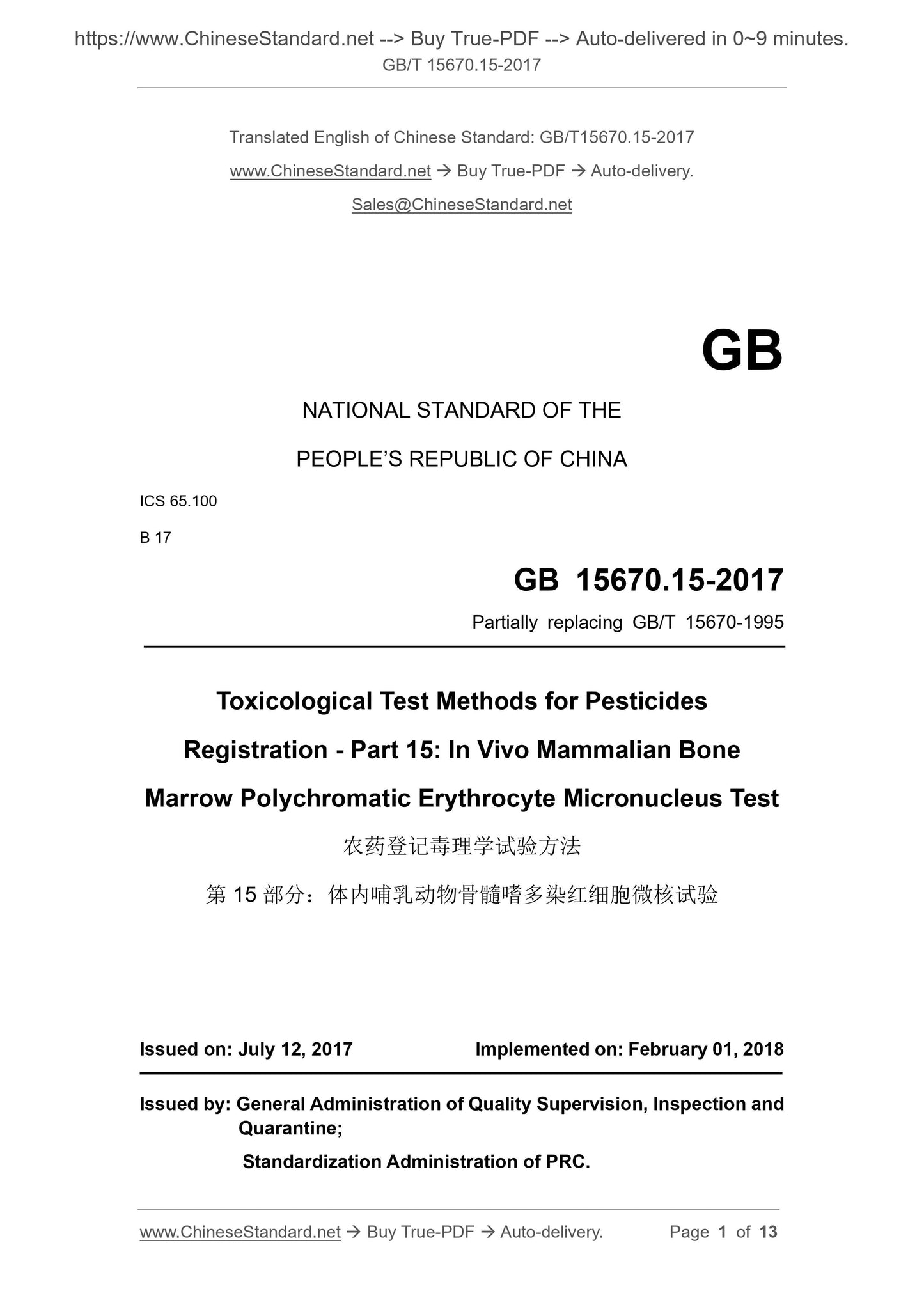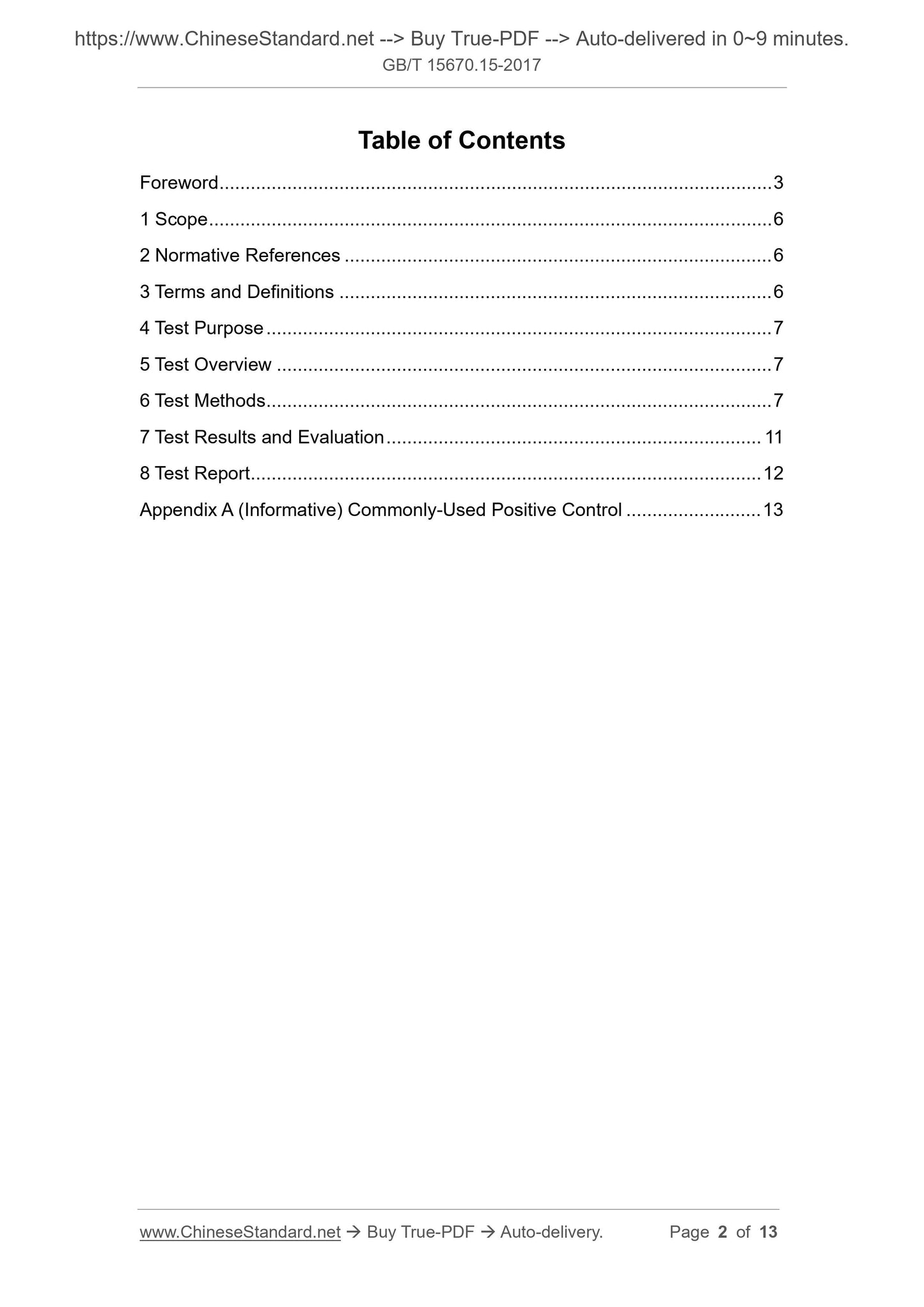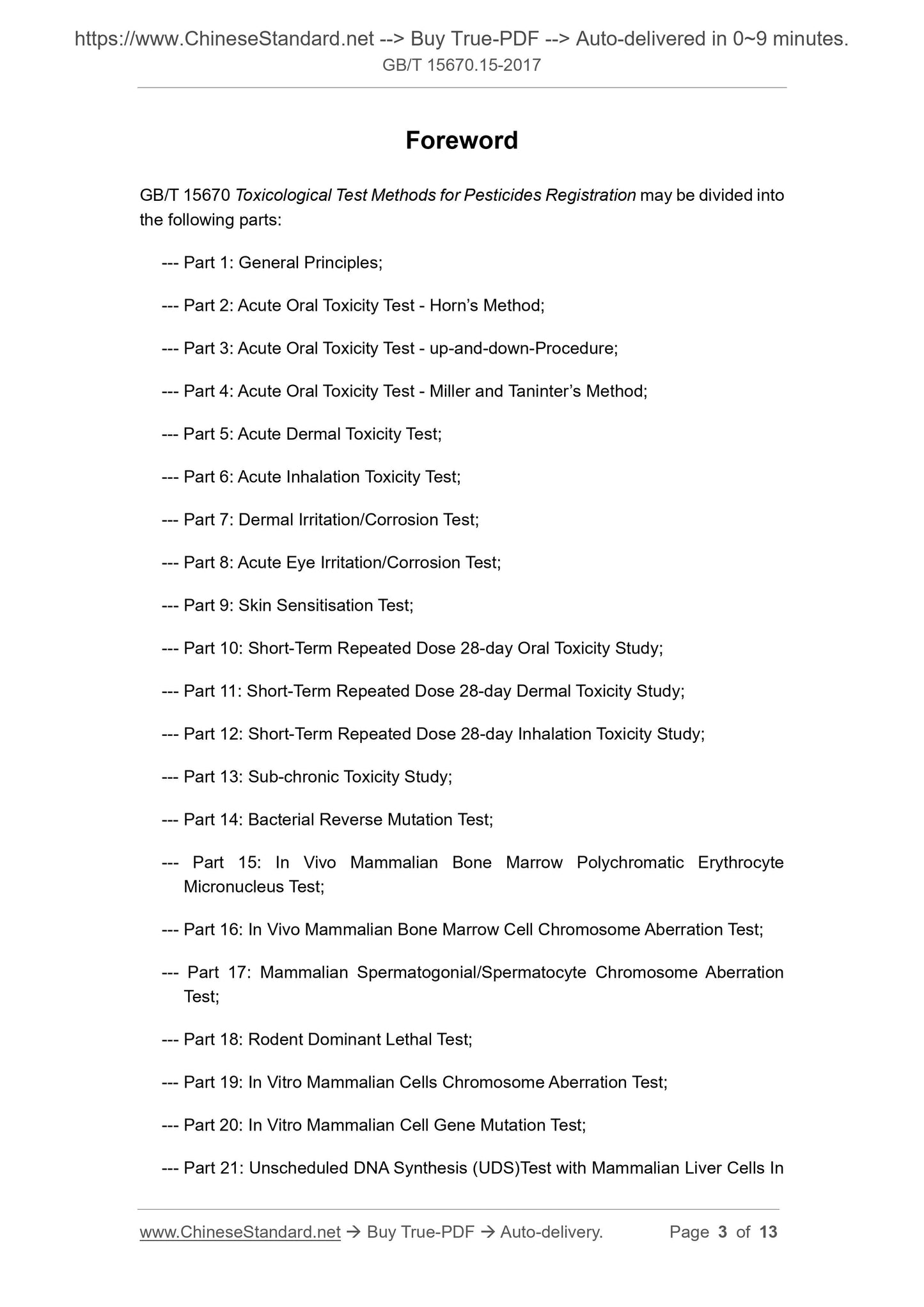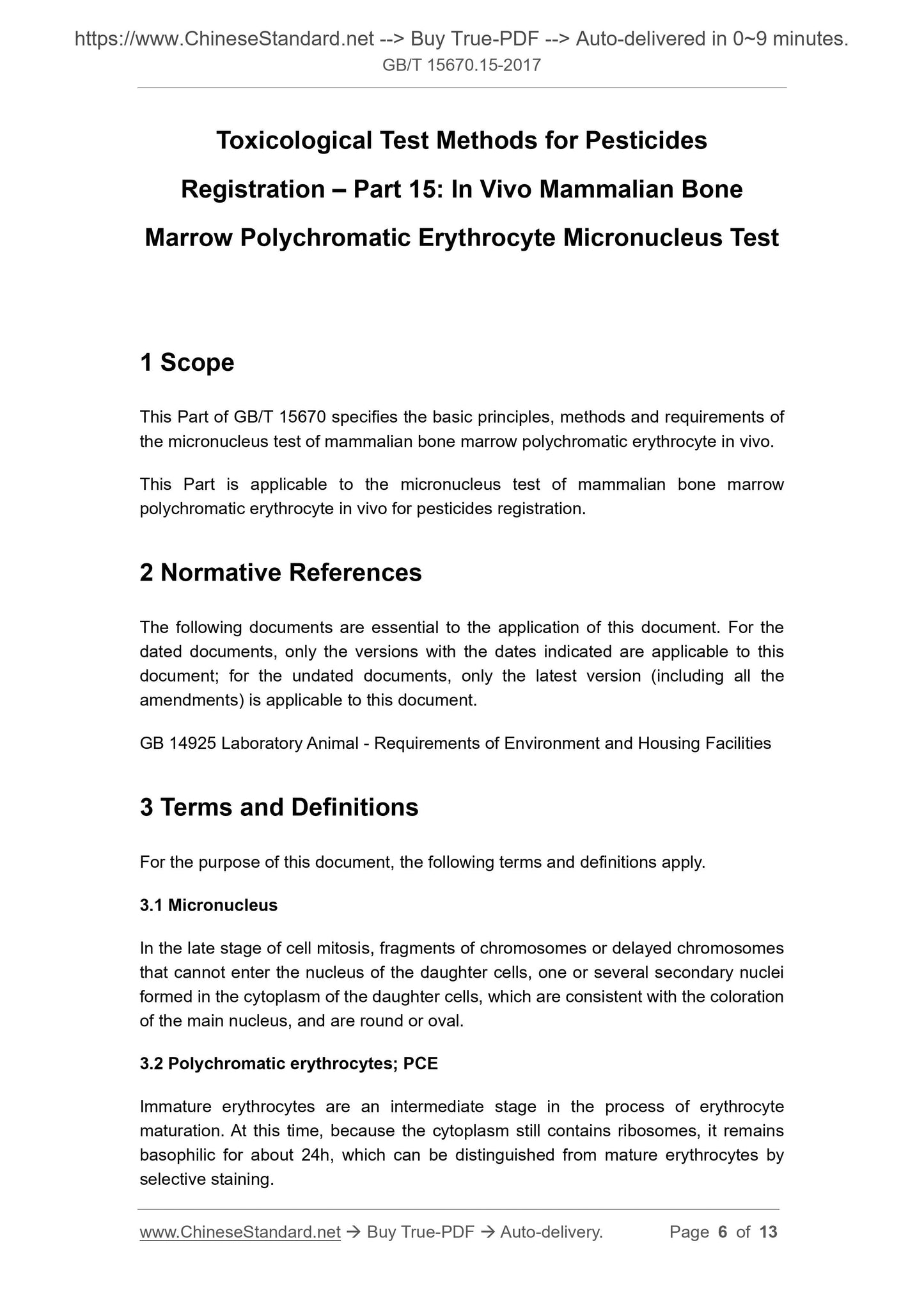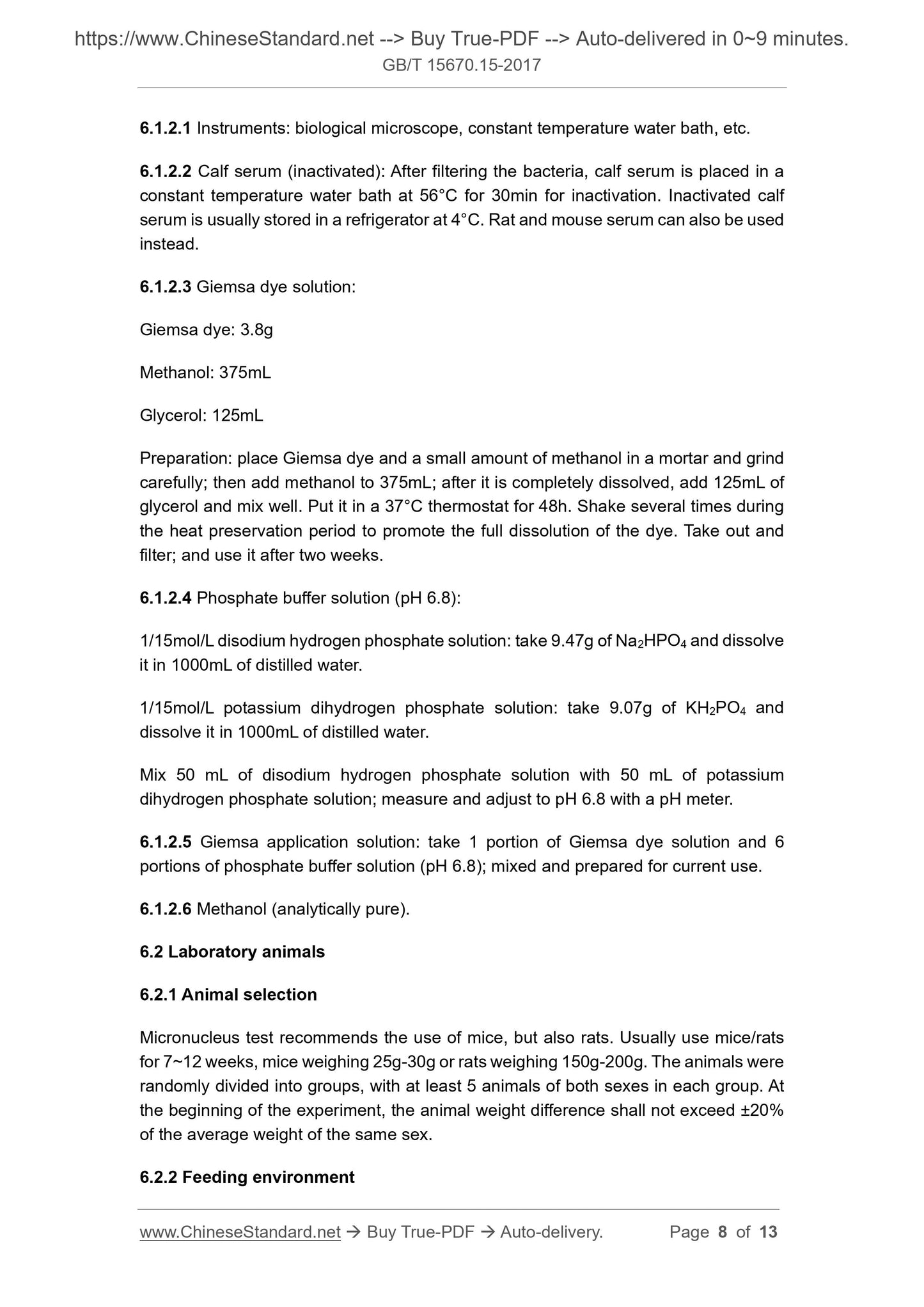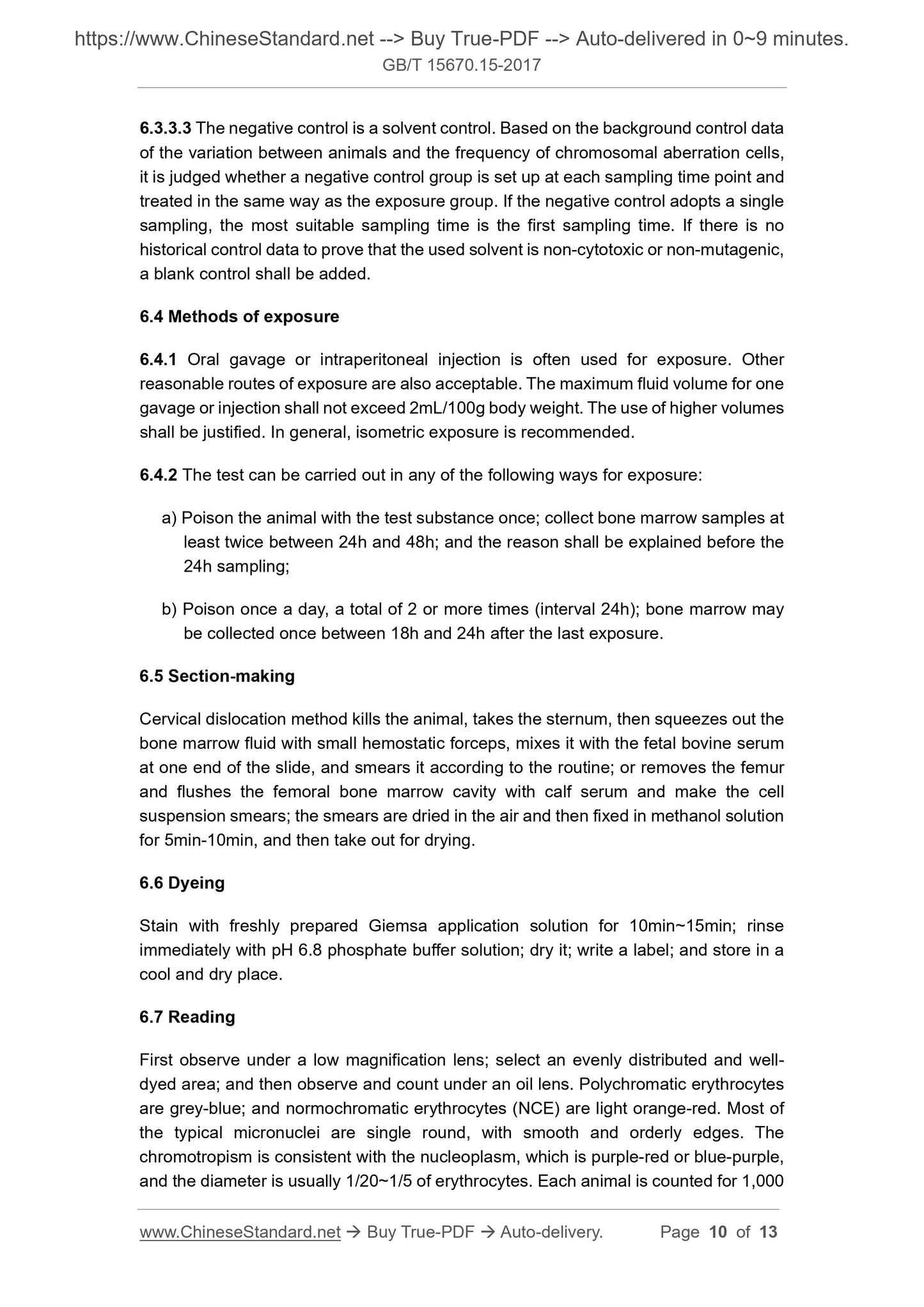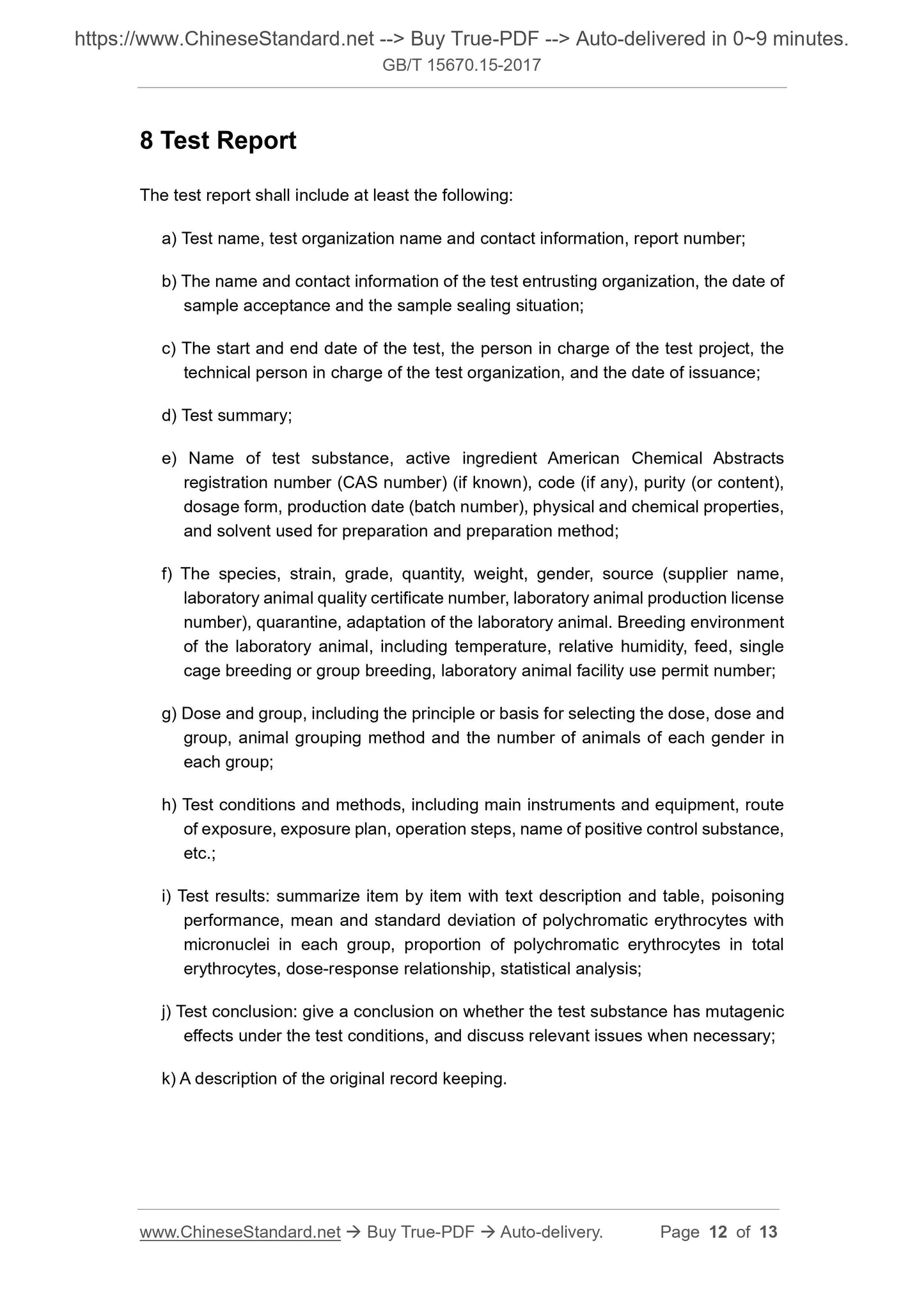1
/
of
7
PayPal, credit cards. Download editable-PDF & invoice In 1 second!
GB/T 15670.15-2017 English PDF (GBT15670.15-2017)
GB/T 15670.15-2017 English PDF (GBT15670.15-2017)
Regular price
$140.00 USD
Regular price
Sale price
$140.00 USD
Unit price
/
per
Shipping calculated at checkout.
Couldn't load pickup availability
Delivery: 3 seconds. Download true-PDF + Invoice.
Get QUOTATION in 1-minute: Click GB/T 15670.15-2017
Historical versions: GB/T 15670.15-2017
Preview True-PDF (Reload/Scroll if blank)
GB/T 15670.15-2017: Toxicological test methods for pesticides registration -- Part 15: In vivo mammalian bone marrow polychromatic erythrocyte micronucleus test
GB/T 15670.15-2017
GB
NATIONAL STANDARD OF THE
PEOPLE’S REPUBLIC OF CHINA
ICS 65.100
B 17
GB 15670.15-2017
Partially replacing GB/T 15670-1995
Toxicological Test Methods for Pesticides
Registration - Part 15: In Vivo Mammalian Bone
Marrow Polychromatic Erythrocyte Micronucleus Test
ISSUED ON: JULY 12, 2017
IMPLEMENTED ON: FEBRUARY 01, 2018
Issued by: General Administration of Quality Supervision, Inspection and
Quarantine;
Standardization Administration of PRC.
Table of Contents
Foreword ... 3
1 Scope ... 6
2 Normative References ... 6
3 Terms and Definitions ... 6
4 Test Purpose ... 7
5 Test Overview ... 7
6 Test Methods ... 7
7 Test Results and Evaluation ... 11
8 Test Report ... 12
Appendix A (Informative) Commonly-Used Positive Control ... 13
Foreword
GB/T 15670 Toxicological Test Methods for Pesticides Registration may be divided into
the following parts:
--- Part 1: General Principles;
--- Part 2: Acute Oral Toxicity Test - Horn’s Method;
--- Part 3: Acute Oral Toxicity Test - up-and-down-Procedure;
--- Part 4: Acute Oral Toxicity Test - Miller and Taninter’s Method;
--- Part 5: Acute Dermal Toxicity Test;
--- Part 6: Acute Inhalation Toxicity Test;
--- Part 7: Dermal Irritation/Corrosion Test;
--- Part 8: Acute Eye Irritation/Corrosion Test;
--- Part 9: Skin Sensitisation Test;
--- Part 10: Short-Term Repeated Dose 28-day Oral Toxicity Study;
--- Part 11: Short-Term Repeated Dose 28-day Dermal Toxicity Study;
--- Part 12: Short-Term Repeated Dose 28-day Inhalation Toxicity Study;
--- Part 13: Sub-chronic Toxicity Study;
--- Part 14: Bacterial Reverse Mutation Test;
--- Part 15: In Vivo Mammalian Bone Marrow Polychromatic Erythrocyte
Micronucleus Test;
--- Part 16: In Vivo Mammalian Bone Marrow Cell Chromosome Aberration Test;
--- Part 17: Mammalian Spermatogonial/Spermatocyte Chromosome Aberration
Test;
--- Part 18: Rodent Dominant Lethal Test;
--- Part 19: In Vitro Mammalian Cells Chromosome Aberration Test;
--- Part 20: In Vitro Mammalian Cell Gene Mutation Test;
--- Part 21: Unscheduled DNA Synthesis (UDS)Test with Mammalian Liver Cells In
Toxicological Test Methods for Pesticides
Registration – Part 15: In Vivo Mammalian Bone
Marrow Polychromatic Erythrocyte Micronucleus Test
1 Scope
This Part of GB/T 15670 specifies the basic principles, methods and requirements of
the micronucleus test of mammalian bone marrow polychromatic erythrocyte in vivo.
This Part is applicable to the micronucleus test of mammalian bone marrow
polychromatic erythrocyte in vivo for pesticides registration.
2 Normative References
The following documents are essential to the application of this document. For the
dated documents, only the versions with the dates indicated are applicable to this
document; for the undated documents, only the latest version (including all the
amendments) is applicable to this document.
GB 14925 Laboratory Animal - Requirements of Environment and Housing Facilities
3 Terms and Definitions
For the purpose of this document, the following terms and definitions apply.
3.1 Micronucleus
In the late stage of cell mitosis, fragments of chromosomes or delayed chromosomes
that cannot enter the nucleus of the daughter cells, one or several secondary nuclei
formed in the cytoplasm of the daughter cells, which are consistent with the coloration
of the main nucleus, and are round or oval.
3.2 Polychromatic erythrocytes; PCE
Immature erythrocytes are an intermediate stage in the process of erythrocyte
maturation. At this time, because the cytoplasm still contains ribosomes, it remains
basophilic for about 24h, which can be distinguished from mature erythrocytes by
selective staining.
6.1.2.1 Instruments: biological microscope, constant temperature water bath, etc.
6.1.2.2 Calf serum (inactivated): After filtering the bacteria, calf serum is placed in a
constant temperature water bath at 56°C for 30min for inactivation. Inactivated calf
serum is usually stored in a refrigerator at 4°C. Rat and mouse serum can also be used
instead.
6.1.2.3 Giemsa dye solution:
Giemsa dye: 3.8g
Methanol: 375mL
Glycerol: 125mL
Preparation: place Giemsa dye and a small amount of methanol in a mortar and grind
carefully; then add methanol to 375mL; after it is completely dissolved, add 125mL of
glycerol and mix well. Put it in a 37°C thermostat for 48h. Shake several times during
the heat preservation period to promote the full dissolution of the dye. Take out and
filter; and use it after two weeks.
6.1.2.4 Phosphate buffer solution (pH 6.8):
1/15mol/L disodium hydrogen phosphate solution: take 9.47g of Na2HPO4 and dissolve
it in 1000mL of distilled water.
1/15mol/L potassium dihydrogen phosphate solution: take 9.07g of KH2PO4 and
dissolve it in 1000mL of distilled water.
Mix 50 mL of disodium hydrogen phosphate solution with 50 mL of potassium
dihydrogen phosphate solution; measure and adjust to pH 6.8 with a pH meter.
6.1.2.5 Giemsa application solution: take 1 portion of Giemsa dye solution and 6
portions of phosphate buffer solution (pH 6.8); mixed and prepared for current use.
6.1.2.6 Methanol (analytically pure).
6.2 Laboratory animals
6.2.1 Animal selection
Micronucleus test recommends the use of mice, but also rats. Usually use mice/rats
for 7~12 weeks, mice weighing 25g-30g or rats weighing 150g-200g. The animals were
randomly divided into groups, with at least 5 animals of both sexes in each group. At
the beginning of the experiment, the animal weight difference shall not exceed ±20%
of the average weight of the same sex.
6.2.2 Feeding environment
6.3.3.3 The negative control is a solvent control. Based on the background control data
of the variation between animals and the frequency of chromosomal aberration cells,
it is judged whether a negative control group is set up at each sampling time point and
treated in the same way as the exposure group. If the negative control adopts a single
sampling, the most suitable sampling time is the first sampling time. If there is no
historical control data to prove that the used solvent is non-cytotoxic or non-mutagenic,
a blank control shall be added.
6.4 Methods of exposure
6.4.1 Oral gavage or intraperitoneal injection is often used for exposure. Other
reasonable routes of exposure are also acceptable. The maximum fluid volume for one
gavage or injection shall not exceed 2mL/100g body weight. The use of higher volumes
shall be justified. In general, isometric exposure is recommended.
6.4.2 The test can be carried out in any of the following ways for exposure:
a) Poison the animal with the test substance once; collect bone marrow samples at
least twice between 24h and 48h; and the reason shall be explained before the
24h sampling;
b) Poison once a day, a total of 2 or more times (interval 24h); bone marrow may
be collected once between 18h and 24h after the last exposure.
6.5 Section-making
Cervical dislocation method kills the animal, takes the sternum, then squeezes out the
bone marrow fluid with small hemostatic forceps, mixes it with the fetal bovine serum
at one end of the slide, and smears it according to the routine; or removes the femur
and flushes the femoral bone marrow cavity with calf serum and make the cell
suspension smears; the smears are dried in the air and then fixed in methanol solution
for 5min-10min, and then take out for drying.
6.6 Dy...
Get QUOTATION in 1-minute: Click GB/T 15670.15-2017
Historical versions: GB/T 15670.15-2017
Preview True-PDF (Reload/Scroll if blank)
GB/T 15670.15-2017: Toxicological test methods for pesticides registration -- Part 15: In vivo mammalian bone marrow polychromatic erythrocyte micronucleus test
GB/T 15670.15-2017
GB
NATIONAL STANDARD OF THE
PEOPLE’S REPUBLIC OF CHINA
ICS 65.100
B 17
GB 15670.15-2017
Partially replacing GB/T 15670-1995
Toxicological Test Methods for Pesticides
Registration - Part 15: In Vivo Mammalian Bone
Marrow Polychromatic Erythrocyte Micronucleus Test
ISSUED ON: JULY 12, 2017
IMPLEMENTED ON: FEBRUARY 01, 2018
Issued by: General Administration of Quality Supervision, Inspection and
Quarantine;
Standardization Administration of PRC.
Table of Contents
Foreword ... 3
1 Scope ... 6
2 Normative References ... 6
3 Terms and Definitions ... 6
4 Test Purpose ... 7
5 Test Overview ... 7
6 Test Methods ... 7
7 Test Results and Evaluation ... 11
8 Test Report ... 12
Appendix A (Informative) Commonly-Used Positive Control ... 13
Foreword
GB/T 15670 Toxicological Test Methods for Pesticides Registration may be divided into
the following parts:
--- Part 1: General Principles;
--- Part 2: Acute Oral Toxicity Test - Horn’s Method;
--- Part 3: Acute Oral Toxicity Test - up-and-down-Procedure;
--- Part 4: Acute Oral Toxicity Test - Miller and Taninter’s Method;
--- Part 5: Acute Dermal Toxicity Test;
--- Part 6: Acute Inhalation Toxicity Test;
--- Part 7: Dermal Irritation/Corrosion Test;
--- Part 8: Acute Eye Irritation/Corrosion Test;
--- Part 9: Skin Sensitisation Test;
--- Part 10: Short-Term Repeated Dose 28-day Oral Toxicity Study;
--- Part 11: Short-Term Repeated Dose 28-day Dermal Toxicity Study;
--- Part 12: Short-Term Repeated Dose 28-day Inhalation Toxicity Study;
--- Part 13: Sub-chronic Toxicity Study;
--- Part 14: Bacterial Reverse Mutation Test;
--- Part 15: In Vivo Mammalian Bone Marrow Polychromatic Erythrocyte
Micronucleus Test;
--- Part 16: In Vivo Mammalian Bone Marrow Cell Chromosome Aberration Test;
--- Part 17: Mammalian Spermatogonial/Spermatocyte Chromosome Aberration
Test;
--- Part 18: Rodent Dominant Lethal Test;
--- Part 19: In Vitro Mammalian Cells Chromosome Aberration Test;
--- Part 20: In Vitro Mammalian Cell Gene Mutation Test;
--- Part 21: Unscheduled DNA Synthesis (UDS)Test with Mammalian Liver Cells In
Toxicological Test Methods for Pesticides
Registration – Part 15: In Vivo Mammalian Bone
Marrow Polychromatic Erythrocyte Micronucleus Test
1 Scope
This Part of GB/T 15670 specifies the basic principles, methods and requirements of
the micronucleus test of mammalian bone marrow polychromatic erythrocyte in vivo.
This Part is applicable to the micronucleus test of mammalian bone marrow
polychromatic erythrocyte in vivo for pesticides registration.
2 Normative References
The following documents are essential to the application of this document. For the
dated documents, only the versions with the dates indicated are applicable to this
document; for the undated documents, only the latest version (including all the
amendments) is applicable to this document.
GB 14925 Laboratory Animal - Requirements of Environment and Housing Facilities
3 Terms and Definitions
For the purpose of this document, the following terms and definitions apply.
3.1 Micronucleus
In the late stage of cell mitosis, fragments of chromosomes or delayed chromosomes
that cannot enter the nucleus of the daughter cells, one or several secondary nuclei
formed in the cytoplasm of the daughter cells, which are consistent with the coloration
of the main nucleus, and are round or oval.
3.2 Polychromatic erythrocytes; PCE
Immature erythrocytes are an intermediate stage in the process of erythrocyte
maturation. At this time, because the cytoplasm still contains ribosomes, it remains
basophilic for about 24h, which can be distinguished from mature erythrocytes by
selective staining.
6.1.2.1 Instruments: biological microscope, constant temperature water bath, etc.
6.1.2.2 Calf serum (inactivated): After filtering the bacteria, calf serum is placed in a
constant temperature water bath at 56°C for 30min for inactivation. Inactivated calf
serum is usually stored in a refrigerator at 4°C. Rat and mouse serum can also be used
instead.
6.1.2.3 Giemsa dye solution:
Giemsa dye: 3.8g
Methanol: 375mL
Glycerol: 125mL
Preparation: place Giemsa dye and a small amount of methanol in a mortar and grind
carefully; then add methanol to 375mL; after it is completely dissolved, add 125mL of
glycerol and mix well. Put it in a 37°C thermostat for 48h. Shake several times during
the heat preservation period to promote the full dissolution of the dye. Take out and
filter; and use it after two weeks.
6.1.2.4 Phosphate buffer solution (pH 6.8):
1/15mol/L disodium hydrogen phosphate solution: take 9.47g of Na2HPO4 and dissolve
it in 1000mL of distilled water.
1/15mol/L potassium dihydrogen phosphate solution: take 9.07g of KH2PO4 and
dissolve it in 1000mL of distilled water.
Mix 50 mL of disodium hydrogen phosphate solution with 50 mL of potassium
dihydrogen phosphate solution; measure and adjust to pH 6.8 with a pH meter.
6.1.2.5 Giemsa application solution: take 1 portion of Giemsa dye solution and 6
portions of phosphate buffer solution (pH 6.8); mixed and prepared for current use.
6.1.2.6 Methanol (analytically pure).
6.2 Laboratory animals
6.2.1 Animal selection
Micronucleus test recommends the use of mice, but also rats. Usually use mice/rats
for 7~12 weeks, mice weighing 25g-30g or rats weighing 150g-200g. The animals were
randomly divided into groups, with at least 5 animals of both sexes in each group. At
the beginning of the experiment, the animal weight difference shall not exceed ±20%
of the average weight of the same sex.
6.2.2 Feeding environment
6.3.3.3 The negative control is a solvent control. Based on the background control data
of the variation between animals and the frequency of chromosomal aberration cells,
it is judged whether a negative control group is set up at each sampling time point and
treated in the same way as the exposure group. If the negative control adopts a single
sampling, the most suitable sampling time is the first sampling time. If there is no
historical control data to prove that the used solvent is non-cytotoxic or non-mutagenic,
a blank control shall be added.
6.4 Methods of exposure
6.4.1 Oral gavage or intraperitoneal injection is often used for exposure. Other
reasonable routes of exposure are also acceptable. The maximum fluid volume for one
gavage or injection shall not exceed 2mL/100g body weight. The use of higher volumes
shall be justified. In general, isometric exposure is recommended.
6.4.2 The test can be carried out in any of the following ways for exposure:
a) Poison the animal with the test substance once; collect bone marrow samples at
least twice between 24h and 48h; and the reason shall be explained before the
24h sampling;
b) Poison once a day, a total of 2 or more times (interval 24h); bone marrow may
be collected once between 18h and 24h after the last exposure.
6.5 Section-making
Cervical dislocation method kills the animal, takes the sternum, then squeezes out the
bone marrow fluid with small hemostatic forceps, mixes it with the fetal bovine serum
at one end of the slide, and smears it according to the routine; or removes the femur
and flushes the femoral bone marrow cavity with calf serum and make the cell
suspension smears; the smears are dried in the air and then fixed in methanol solution
for 5min-10min, and then take out for drying.
6.6 Dy...
Share
